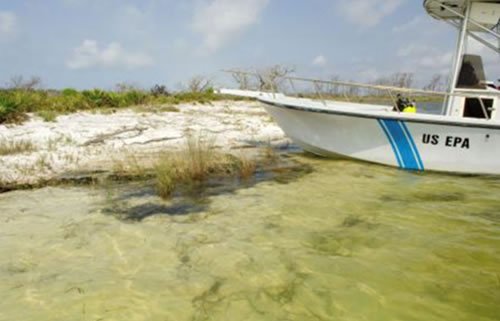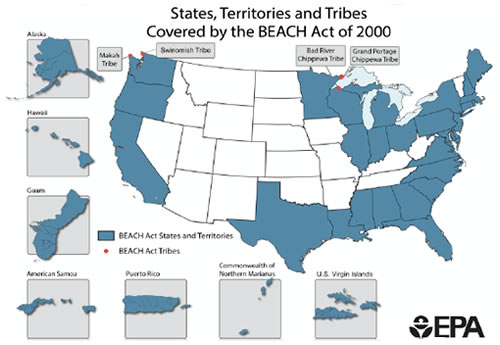EPA's Beach Program: Safe to Swim or Stick to Shoreline?
June 2020

Nobody wants their beach vacation to mean they risk getting ill because they're exposed to polluted water and sand. Thanks to a law passed 20 years ago, here in the SNEP region, regular monitoring takes place to allow people to enjoy our beaches while also keeping them safe from illness. Stormwater runoff, which refers to water that drains from the land after a rainfall, and untreated sewage released into coastal areas can expose visitors to harmful microorganisms called pathogens. The Beaches Environmental and Coastal Health Act, or the BEACH Act, was signed into law on October 10, 2000 to reduce the risk of disease to users of the Nation's marine recreational waters, The Act required EPA to develop performance criteria for testing, monitoring, and notifying public users of possible recreational water problems in order to identify high-risk beaches, mitigate sources of pollution, and better communicate risks to the public.
EPA's BEACH Act Grant Program, commonly known as the "Beach Program," provides grants to states, territories, tribes, and local governments to meet the aims of the BEACH Act. Grant recipients can use the money to designate their own water quality standards based on EPA recommendations and implement monitoring and notification programs for coastal recreational waters like the marine coastal waters (including coastal estuaries) in the SNEP region used for swimming, bathing, surfing, or similar recreational activities. Each beach season, state and local departments of public health and/or environmental protection monitors water quality for bacterial contamination. Water samples are examined for the number of colony forming units, or "cfus", per unit of water. If the number of indicator organism cfus (including parasites, protozoa, viruses, and bacteria like the Enterococci genus commonly found in human and animal feces) exceeds a given state's standard, the responsible agency should post a beach advisory or closing.
Testing frequency varies from daily to monthly depending on a beach's annual traffic and its likelihood of having water quality issues. Infrequently used beaches or beaches with historically few issues are categorized as Tier 3 and are tested less often, while popular beaches and beaches with consecutive bacterial exceedances are categorized as Tier 1 and are tested more frequently. The EPA maintains a public database, BEACON 2.0 (or Beach Advisory and Closing Online Notification), of historic pollution occurrences for coastal recreational waters. "One of the benefits of collecting long-term beach data is that states can initiate precautionary advisories and closures after heavy rains on beaches with a history of consecutive bacterial exceedances, protecting beachgoers in instances when data analysis is delayed," says Alicia Grimaldi of EPA's Ocean and Coastal Protection Unit.
While Beach Program grants are limited to water quality monitoring and notification activities, towns, cities, tribes and states funded by the Program are encouraged to take historical data a step further. In the SNEP region, Massachusetts and Rhode Island are quick to take initiative by testing novel technologies and encouraging nonprofits like Rhode Island's Clean Ocean Access to pursue additional monitoring to track sources of pollution. As a result, Massachusetts and Rhode Island beaches have remained open for an average of 98% of each season since 2010. Bacterial exceedances, precautionary closures, and other beach advisories have only occurred during 2% of the beach season on average across both states. This 2020 season will be different due to public access restrictions, but New England states hope that by opening later in the year they can learn from states that open their beaches sooner, in their response to COVID-19.
Beach Program grant allocations are based on the length of the beach season, the number of shoreline miles, and the coastal county population densities. There are currently 30 states, 5 territories, and 4 tribes eligible to apply for funding. Since 2002, EPA has awarded nearly $177 million in grants for beach monitoring and notification programs, though declining funding in recent years may impact the scope of future awards. Interested coastal residents can visit EPA's BEACON 2.0 site for historical data, EPA's Beaches site for information on the types of pollution, erosion, and habitat degradation that can impact beaches and corresponding human health impacts, and EPA's Beach Grants site for funding history. Massachusetts residents can visit the MA Department of Public Health site and Rhode Island residents can visit the RI Department of Health site for local beach updates.
Please direct any questions to Alicia Grimaldi ([email protected]).

